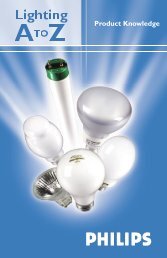triad® electronic ballasts - Conserve-A-Watt Lighting, Inc
triad® electronic ballasts - Conserve-A-Watt Lighting, Inc
triad® electronic ballasts - Conserve-A-Watt Lighting, Inc
Create successful ePaper yourself
Turn your PDF publications into a flip-book with our unique Google optimized e-Paper software.
GlossaryGlossaryHigh Efficiency (Energy Saving) Electromagnetic Ballast–Ballast with Core & Coils, designed to minimize ballast lossescompared to the “standard” ballast.High Intensity Discharge (HID) Lamp–A lamp containinga filled arc tube in which the active element becomes vaporized(a gaseous state) and is discharged into the arc streamto produce light.High Power Factor–A ballast whose power factor is corrected to90% or greater by use of a capacitor.<strong>Inc</strong>andescent Lamp–Lamp in which light is produced by afilament heated by an electric current.Input Voltage–Power supply voltage required for proper operationof an arc discharge lighting ballast.Inputs <strong>Watt</strong>s–The total power input to the ballast whichincludes lamp watts and ballast losses. The total power input tothe fixture is the input watts to the ballast or <strong>ballasts</strong> and is thevalue to be used when calculating cost of energy and air conditioningloads.Instant Start Lamp–a fluorescent lamp with a single pin at eachend. The lamp is ignited by a high voltage without anyfilament heating.Instant Start–Lamp starting method in which lamps arestarted by high voltage input with no preheating of lampfilaments. Some rapid start lamps are designed so that they maybe instant started.Laminations–Layers of steel, making up the “core” that is surroundedby the coils in a core & coil <strong>ballasts</strong>.Lamp Current Crest Factor–See “Crest Factor”.Lamp Filament–See “Electrode”.Lamp <strong>Watt</strong>s –Input power used to operate lamps.Lumens/<strong>Watt</strong>–A measurement of white light produced by each outputwatt.Metal Cases–Case design used in both magnetic and<strong>electronic</strong> <strong>ballasts</strong>. These <strong>ballasts</strong> are grounded once theyare mounted to the fixture. They meet all safety codes, someof which do not allow plastic in open plenum areas.National Electric Code (NEC)–A nationally accepted electricalinstallation code to reduce the risk of fire, developed by theNational Fire Protection Association.National Energy Standards for Fluorescent Ballasts–A federallaw enacted in 1988 that sets energy standards for <strong>ballasts</strong> consistentthroughout the United States.NOM –Laboratory that sets safety standards for building materials,electrical appliances and other products for Mexico.Non-PCB Capacitor–Capacitor used in <strong>ballasts</strong> to help providepower factor correction. Contains no polychlorinated biphenylsand meets EPA requirements.Normal Power Factor–Ballasts with power factor less than .90and do not incorporate any means of Power Factor Correction.Parallel Lamp Operation–Refers to <strong>ballasts</strong> that employ multiple-outputcurrent paths from a single ballast to allow lamps tooperate independent of one another, allowing other lamps operatedby the ballast to remain lit should companion lamp(s) fail.PAGE 7-2PCB (Polychlorinated Biphenyls)–Chemical pollutant formerlyused in ballast capacitors.Potting–Material used to completely surround and covercomponents of some magnetic and <strong>electronic</strong> <strong>ballasts</strong>.Potting compound fulfills functions of protecting components,dampening sound, and dissipating heat.Power Factor–Measurement of the relationship between the ACsource voltage and current. High power factor <strong>ballasts</strong> requireless AC operating current operating at the same wattage thanan equivalent low power factor ballast. Formula: Power Factorequals Input <strong>Watt</strong>s divided by the product ofLine Volts times Line Amps (Volt Amps or VA).Power Factor Corrected–Ballasts that incorporate a meansof Power Factor Correction but whose power factor is 50%.Preheat Lamp–A fluorescent lamp in which the filament mustbe heated by use of a starter before the arc is created. Theselamps are typically operated with electromagnetic <strong>ballasts</strong>.Programmed Rapid Start–lamp starting method whichpreheats the lamp filaments while not allowing the lamp to igniteand then applies the open circuit voltage (OCV) to start the lamp.The user may experience a half to one-second delay after turningon the lamps while the pre-heating takes place. This type of startingcircuit keeps lamp end blackening to a minimum and improveslamp life performance, especially in applications where the lampsare frequently switched on and off.Rapid Start Lamp–A fluorescent lamp with two pins at eachend connected to the filament. The filaments are heated by theballast to aid in starting. Some rapid start lamps may be instantstarted without filament heat, for example, the F32T8 lamp.Rapid Start–Lamp starting method in which lamp filaments areheated while open circuit voltage (OCV) is applied tofacilitate lamp ignition.Series Lamp Operation–Refers to <strong>ballasts</strong> that employ asingle current path passing through all lamps operated by theballast. If one lamp should fail, companion lamps operated bythe same <strong>ballasts</strong> will also extinguish or dim.Standard Alternating Current Frequency in the United States–60 Hertz (Hz) or 60 cycles per second.Total Harmonic Distortion (THD)–The combined effect ofHarmonic Distortion on the AC waveform produced by a ballastor other device. Expressed as a percentage. Excessive levels ofTHD can create large currents on the neutral line of a four-wireWye three phase system. (See “Harmonic Distortion”.)Transients–High voltage surges through an electrical systemcaused by lightning strikes to nearby transformers, overheadlines or the ground. May also be caused by switching of motorsand compressors, as well as by short circuits or utility systemswitching. Can lead to premature ballast failure.Two-Pin Compact Fluorescent Lamps–Type of lamps thathave the glow bottle starter built into the base of the lamp.Traditionally 2-pin lamps are designed to work withelectromagnetic <strong>ballasts</strong>.UL (Underwriters’ Laboratories, <strong>Inc</strong>.)–Laboratory thatsets safety standards for building materials, electricalappliances and other products.<strong>Watt</strong>s–Measurement of electrical ability to do work.FOR MORE INFORMATION CALL1-800-BALLAST(225-5278)




